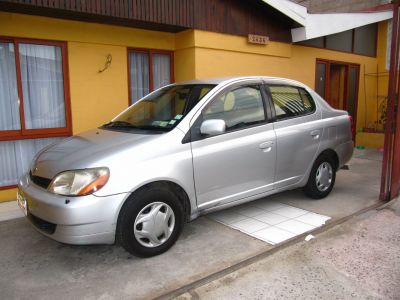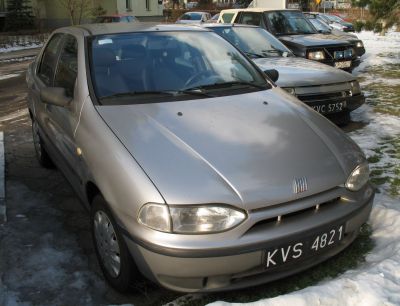 1973 Lada 21035 Dimensions, Size & Specs
1973 Lada 21035 Dimensions, Size & Specs
Measurements of the 1973 Lada 21035, engineered for optimal performance and comfort
| Dimensions | |
|---|---|
| Length: | 4116 mm162.0 in13.5 ft |
| Width: | 1611 mm63.4 in5.3 ft |
| Height: | 1440 mm56.7 in4.7 ft |
| Trunk Capacity (Max): | 400 liter14.1 cu ft |
| Weight Specifications | |
| Curb Weight: | 965 kg2127 lbs |
| Maximal permitted Weight: | 1430 kg3153 lbs |
| Tire Specifications | |
| Tire Size: |
|
The Lada 2103, internally designated as the 21035 generation, is a classic Soviet-era sedan produced between 1972 and 1983. A favored model in the Lada lineup, the 2103 combined functional design with practical size, aimed at providing a comfortable family car suitable for diverse driving conditions. Measuring 4116 mm (161.9 inches) in length, 1611 mm (63.4 inches) in width, and standing 1440 mm (56.7 inches) tall, the 2103 falls into the compact sedan category by today's standards while offering a spacious enough cabin for its time.
Weighing 965 kg (2128 lbs) in curb weight, the vehicle was engineered to maximize efficiency without sacrificing solidity, with a maximum allowable weight of 1430 kg (3152 lbs). This balance made the Lada 2103 agile yet stable on the road. The luggage capacity with the rear seats folded reaches up to 400 liters (14.1 cubic feet), showcasing its utility for family trips or daily errands. The car rides on 175/70 SR13 tires, optimized for comfort and control typical of the early 1970s sedans.
As one of the more distinguished models from AvtoVAZ during the Soviet period, the Lada 2103 is often noted for its combination of durability, straightforward maintenance, and size that accommodated both urban and rural environments. It remains a notable vintage model for enthusiasts and collectors interested in Eastern European automotive history and classic compact sedans.
Discover the standout features that make the 1973 Lada 21035 a leader in its class
Have a question? Please check our knowledgebase first.
The Lada 2103 21035 generation measures 4116 mm (161.9 inches) in length, 1611 mm (63.4 inches) in width, and 1440 mm (56.7 inches) in height. These compact dimensions make it suitable for urban and suburban driving, providing a balance between maneuverability and passenger space typical for sedans in the early 1970s.
The Lada 2103 (21035 generation) has a curb weight of approximately 965 kg (2,128 lbs), which is the weight of the vehicle without passengers or cargo but with standard equipment and fluids. Its maximum permissible weight is 1430 kg (3,153 lbs), meaning it can safely carry passengers and cargo up to about 465 kg (1,025 lbs). This weight range ensures decent performance and safety given the sedan’s size and construction.
When the rear seats of the Lada 2103 21035 are folded down, the suitcase and cargo capacity expands up to 400 liters (approximately 14.1 cubic feet). This capacity is quite practical for a mid-sized sedan of that era, allowing for flexibility in carrying larger items or increased baggage during trips.
A standard single-car garage typically measures around 2.4 meters (8 feet) in width and 4.8 meters (16 feet) in length. The Lada 2103 21035, with a width of 1.611 meters (63.4 inches) and length of 4.116 meters (161.9 inches), fits comfortably within these dimensions, allowing not only for parking but also some space to open doors and walk around the vehicle inside the garage.
The Lada 2103 21035 is 1611 mm (63.4 inches) wide, which is relatively narrow compared to many Western European and American sedans of the 1970s that were often wider, typically ranging from 1700 mm (67 inches) to over 1800 mm (71 inches). This narrower width reflects its design focus on efficiency and practicality, suitable for tighter urban roads and limited parking spaces common in Eastern Bloc countries.
The Lada 2103 21035 is equipped with 175/70 SR13 tires. These 13-inch diameter tires with a relatively high sidewall (70% of the tire width) provide a good balance between ride comfort and handling. The tire specifications were typical for cars of that size and era, offering sufficient cushioning over rough roads without compromising too much on responsiveness.
Compared to its predecessor, the Lada 2101 series, the 2103 generation is slightly larger and more refined. The 2103 offers improvements in length and width, bringing more interior space and comfort to passengers. While the exact dimensions of the 2101 can vary slightly by model year and variant, the 2103’s increase in size also came with enhanced engine options and exterior styling that set it apart positively from the earlier 2101.
When compared to similar compact sedans from other manufacturers in the early 1970s, such as the Volkswagen Passat or the Ford Escort, the Lada 2103 21035 is modestly sized but competitive. Its length of 4116 mm (161.9 inches) and width of 1611 mm (63.4 inches) place it in the compact to mid-size category. While slightly narrower and less long than some Western counterparts, it offers a robust build and practical interior space typical of Soviet-era vehicles, favoring utilitarian design over luxury.
The Lada 2103 21035, produced between 1972 and 1983, was known for its relatively advanced features for an Eastern Bloc vehicle at the time. It included upgraded suspension for better ride comfort, a more powerful engine compared to earlier models, and improved interior amenities such as better instrumentation and trim. Despite being utilitarian in nature, it offered decent reliability and ease of maintenance, which contributed to its popularity in domestic and export markets.
The production period of 1972 to 1983 for the Lada 2103 21035 represents an important era in Soviet automotive history when the Soviet Union aimed to produce more modern and comfortable family sedans for its citizens and export markets. The 2103 was part of the broader VAZ lineup and symbolized a move towards more Western-style cars with features like improved styling and better mechanical components. Introduced in 1973 as a model year, it maintained a strong presence on roads for over a decade, underscoring its role as an accessible yet respectable vehicle of its time.
Discover similar sized cars.

| Production: | 1999-2005 |
|---|---|
| Model Year: | 2000 |
| Length: | 4145 mm163.2 in |
| Width: | 1660 mm65.4 in |
| Height: | 1500 mm59.1 in |

| Production: | 1999-2005 |
|---|---|
| Model Year: | 1999 |
| Length: | 4145 mm163.2 in |
| Width: | 1660 mm65.4 in |
| Height: | 1500 mm59.1 in |

| Production: | 1996-2002 |
|---|---|
| Model Year: | 1996 |
| Length: | 4100 mm161.4 in |
| Width: | 1614-1626 mm63.5-64.0 in |
| Height: | 1445 mm56.9 in |

| Production: | 1990-2001 |
|---|---|
| Model Year: | 1990 |
| Length: | 4116 mm162.0 in |
| Width: | 1611 mm63.4 in |
| Height: | 1440 mm56.7 in |

| Production: | 1977-1983 |
|---|---|
| Model Year: | 1977 |
| Length: | 4116 mm162.0 in |
| Width: | 1611 mm63.4 in |
| Height: | 1440 mm56.7 in |

| Production: | 1972-1983 |
|---|---|
| Model Year: | 1972 |
| Length: | 4116 mm162.0 in |
| Width: | 1611 mm63.4 in |
| Height: | 1440 mm56.7 in |
